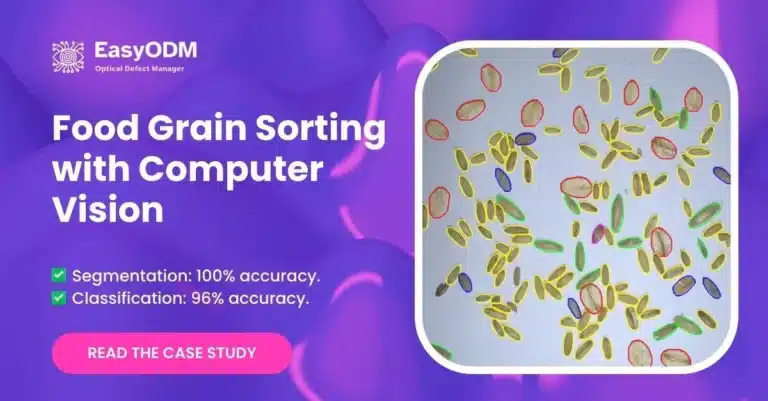Artificial Intelligence (AI) is revolutionizing many sectors, including the grain feed industry. AI enhances various aspects of grain feed production and management, from quality testing to optimizing logistics and manufacturing processes.
It is increasingly important for ensuring high-quality grain feed, which is crucial for livestock diets.
Key Takeaways
- Raw Grain Quality: AI improves the quality testing of raw grain, ensuring only the best grains are used in grain feed.
- Enhanced Quality Testing: AI tools, such as EasyODM’s grain sample analysis, detect grain defects with up to 96% accuracy.
- Predicting Demand and Logistics: AI enhances the efficiency of grain traders and brokers by optimizing logistics and predicting demand.
- Automated Production Scheduling: Feed manufacturers benefit from AI through automated production scheduling and reduced waste.
- Consistent Feed Quality: AI helps produce consistent and high-quality final feed products, enhancing livestock health.
- Future Forecasting: Future AI advancements promise automated feed forecasting and more efficient production with minimal human intervention.
AI in Quality Testing of Raw Grain
Quality testing is a crucial step in the grain feed industry. Previously, grain quality was checked using equipment that often lacked precision and required frequent manual intervention.
AI is now transforming this process by providing more accurate and efficient analysis. AI systems analyze grain samples to detect defects, contamination, and other quality issues, ensuring high standards in grain feed.
AI tools, such as EasyODM’s grain sample analysis, offer up to 96% accuracy in detecting grain defects. This precision ensures that only top-quality grains are used in grain feed production.
AI’s Impact for Grain Traders and Brokers
Grain traders and brokers are essential in the grain feed industry. They connect farmers with feed manufacturers and manage the logistics of grain supply. AI has greatly improved their operations by offering advanced tools for data analysis and decision-making. Here are some significant improvements AI makes for grain traders and brokers:
- AI Forecasting: AI can reduce forecasting errors by 20-50%, leading to better decision-making and cost savings.
- AI-Powered Logistics Optimization: AI reduces transportation costs by 15% by optimizing delivery routes and schedules using real-time data.
- Demand Prediction: AI accurately forecasts grain demand, consequently improving purchasing decisions and inventory management.
- Supply Chain Efficiency: AI enhances supply chain efficiency by minimizing delays and ensuring timely delivery of high-quality grain.
By integrating AI, traders and brokers can better manage their operations, predict market changes, and optimize logistics, leading to more efficient and cost-effective processes.


Enhancing Feed Manufacturing Processes
Feed manufacturers play a crucial role in the grain feed industry. They process raw grains into various types of feed tailored to livestock needs, including cattle feed. AI technology is increasingly being used to improve feed manufacturing. It offers several benefits, including:
- Improved Production Scheduling: AI aligns production schedules with real-time demand, significantly reducing waste and inefficiencies.
- Automated Quality Testing: AI automates quality testing on production lines, ensuring that only high-quality grains are used in feed.
- Waste Reduction: AI’s predictive analytics help minimize waste by closely matching feed production with livestock needs.
Feed manufacturers benefit from AI by automating scheduling and quality control. This improves efficiency and consistency in feed production.
AI’s ability to manage ingredient inventory and streamline procurement processes is also crucial for reducing waste and optimizing production levels.
Automating Ingredient Tracking
AI will soon automate ingredient inventory tracking and procurement. Currently, most ingredient bins are checked manually, leading to inconsistent data. AI will streamline this process, providing accurate, real-time data and improving ingredient management.

Cost Effectiveness with Feeding Formulations
Cost-effective feed rations are essential for enhancing resilience in the livestock industry. Effective feed cost management requires understanding the specific nutrient needs of livestock at various growth stages.
By optimizing feed formulations, significant cost reductions can be achieved while maintaining animal performance.
Nutritional balance
AI helps in feed formulation by analyzing ingredient costs and nutritional value. This ensures that feed formulations are both cost-effective and tailored to the specific needs of livestock.
AI can adjust nutritional requirements to balance cost and performance, improving overall economic efficiency in feed production.
The Future of Grain Feed with AI
AI is expected to drive major advancements in the grain feed industry. One of the key areas for future development is feed forecasting. Although AI is not yet fully capable of automating feed forecasting, it is expected to greatly enhance its accuracy and efficiency. Here are two major future developments:
- Automated Feed Forecasting: AI will eventually automate feed forecasting, predicting grain feed demand with high accuracy and reducing the need for human intervention.
- Improved Efficiency: AI will optimize feed production by using data on growth curves, environmental conditions, and feed consumption, making the process more efficient.
As AI continues to evolve, it will further improve the efficiency of feed production and delivery, benefiting the entire supply chain.
Expert Opinion
DP Techlink, led by CEO Shindelar, anticipates that feed forecasting will significantly enhance feed production and delivery. By automating feed ordering, AI will align it with real-time data and reduce waste.
This precision will ensure that livestock receive the correct feed at the right time, meeting the growing demand for high-quality grain feed.
Conclusion: AI Driving the Future of Grain Feed
AI is transforming the grain feed industry by improving quality testing, optimizing production, and predicting demand. With AI technology, the industry can enhance efficiency, maintain high quality, and deliver the best grain feed products.
As AI continues to advance, it promises to bring even more improvements to feed quality and safety, benefiting both livestock and consumers.


